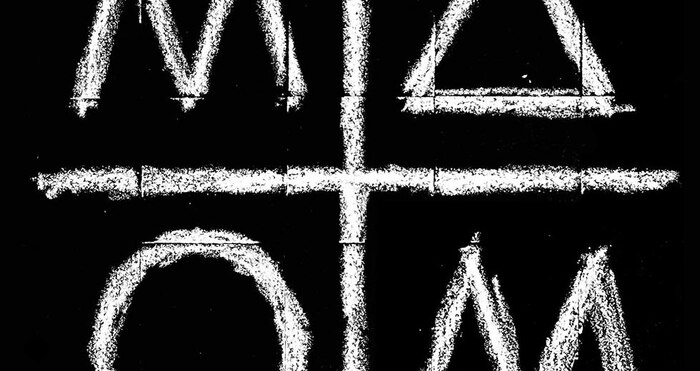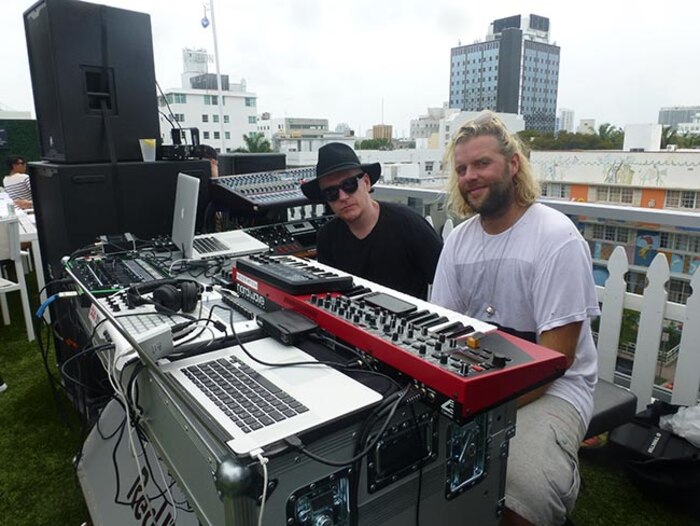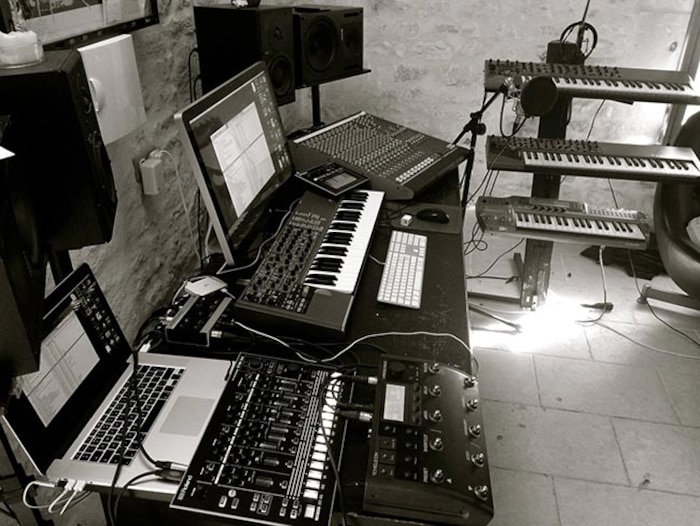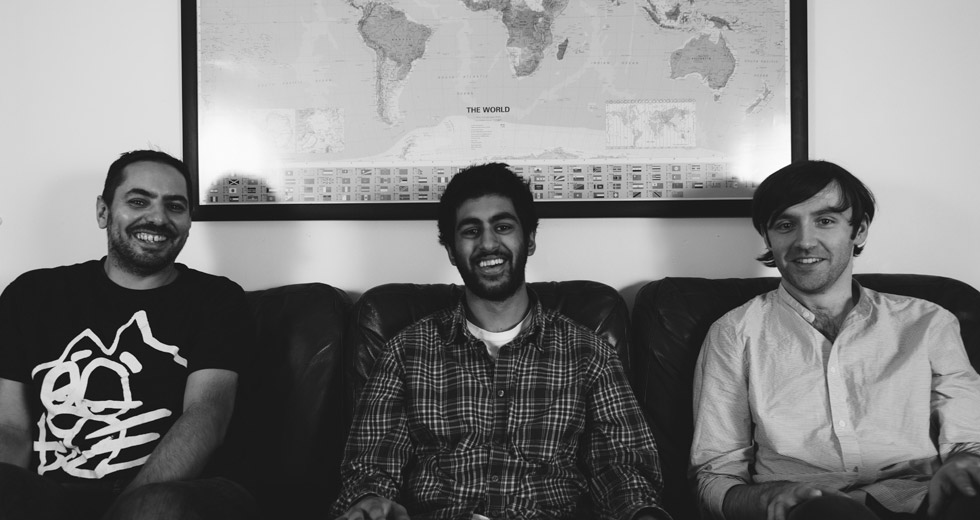Interview: Matom on Their Hansa Studio-Inspired Album
Radio Slave and Cagedbaby talk about the impact of the legendary Berlin studio on their new project.

Hansa Studio is a German music institution with a distinctively cosmopolitan flavour. Much of what was recorded at Köthener Straße represented a large swathe of popular and experimental German music – Tangerine Dream’s unsettling space horror OST, Zeit, was created in the same space that inspired Nina Hagen Band’s outrageously expressive rock records and the rose-tinted schlager songs of Udo Jürgens and Costa Cordalis. But some of Hansa’s most famous album-length exports were quintessentially British affairs. David Bowie’s so-called Berlin trilogy – Low, Heroes, and Lodger – proved hugely beneficial to Bowie, and offered the world an intoxicating glimpse into a city of artists and punks who perhaps couldn’t have existed anywhere else.
Though much has changed in the decades since, Bowie and Berlin is a double act that still inspires; a debut album from Radio Slave and Cagedbaby (AKA Matt Edwards and Thomas Gandey), together as Matom, is a case in point. Originally the result of a commission to make an hour of music based on Bowie’s Low period and Iggy Pop’s The Idiot (an album also recorded at Hansa and produced by Bowie), the Matom project took off in 2011 and played in venues such as Berghain Kantine and the Meistersaal, the iconic chamber music concert hall built in 1910 that was, for a time, attached to Hansa.
As electronic music producers, Edwards and Gandey aren’t obvious candidates to put together an album conceived in tribute to the Thin White Duke, but Hansa’s dance music roots are stronger than you might imagine: Nitzer Ebb, Depeche Mode, and Erasure have all spent time in the Berlin-Mitte studio. Matom’s Love Mistakes, then, is a tribute album of sorts, but more importantly, it’s a document of two producers working with a renewed focus to make something that has moved far beyond its original remit, showing a scope and ambition not dissimilar to that of one of Europe’s most storied studios.
How did you two meet?
Thomas Gandey: Matt and I first met when we both lived in Brighton. I had a studio a few hundred metres from his house.
Matt Edwards: I moved to Brighton at the end of the ’90s. I think I met Tom through this club called Stompa Phunk. His studio was literally two or three minutes from my house. After I had dinner with my wife, I used to escape and go hang out with Tom nearly every evening! I learned a lot from him. At the time I was getting my head around working on my own in the studio.
Thomas Gandey: We first collaborated on a project called Seadevils, which we put out a couple of remixes for. This was around 2003, but then Matt moved to Berlin and I moved to France. We always kept in touch as our careers grew. We’d often meet on the road while touring, and did the occasional work together in the studio, but it wasn’t until 2009 that we actually start recording properly.
I haven’t come across the Seadevils project.
Thomas Gandey: Yeah, it was pretty underground. I also played keyboards on some of Matt’s Quiet Village tracks, which in essence may be an early form of Matom. I’d always admired Matt’s production and minimal approach. I’d always been a bit more of a complex producer, putting a lot of parts into the tracks, probably as a result of my keyboard history being a player and performer. We kind of took that template [from Quiet Village material] for Matom.
I can hear it right away, actually.
Thomas Gandey: Yes, I think Maxxi & Zeus’ “The Struggle,” [released in 2010 on International Feel] more than any other inspired us to start Matom. We were working on the project for quite a while. This album is the culmination of about four years’ work on and off, so we had plenty of time to hone it and get it perfect.
How did the Matom project come about?
Thomas Gandey: RBMA asked Matt to create some music around the music recorded at Hansa studios. Matt chose Bowie and Iggy, and this was the gel that pulled us together. We had already started an album at my studio in Bordeaux. Hansa was just the subject matter, and the location of the first live show. Matt and I had started to record a piano-based album of experimental music, and we had many ideas. Hence some of the track names are “Experiment 7 Variation 2,” as we literally had five or six versions of every track.
Matt came out to my studio outside Bordeaux. I live on a vineyard right in the heart of cognac country, and we wrote unaccompanied piano pieces – just solo and in free time with no backing or meter. After we had about 30 or 40 of these jams down, we then selected and developed five of them. Then the rest of the tracks on the album were initially inspired by the Hansa sessions, which we then re-recorded. So there are no samples on the album – they were just for inspiration.
Hansa was more integral to the tying together of the Matom project as a body of work; we had already started to record a concept piano album and RBMA gave us the opportunity to turn this into a feature project. I had the opportunity to work with Iggy Pop when I was producing with Fatboy Slim, and my voice for my Cagedbaby persona is often very kindly compared to David Bowie, although I am not a super fan of either of them. But I love the legendary status of both artists and how Bowie, especially, changed over the years to lead trends.
How much of Hansa’s history and music had you been aware of before taking on this project?
Thomas Gandey: To be honest, Matt was very aware of the Hansa history and past, and to me it was a learning curve. I knew literally nothing. I had only visited Berlin a few times. I was totally discovering it for the first time. I guess it is the equivalent of London’s Abbey Road.
Matt Edwards: Of course, I loved albums like Low. It’s an amazing album. And also Iggy Pop’s “Nightclubbing,” on The Idiot. Those albums were pretty amazing. Looking back, especially at the late ’90s and ’00s, Joel [Martin, of Quiet Village] and I were buying a lot of rock and pop 12-inches for these extended versions, and a lot of them were actually German and recorded at Hansa studios.
When it came to Tom and I making this music, we listened to a lot of these records, but at the time I was also really heavily into Klaus Schulze, Innovative Communication, and German producers like Manuel Gottsching, especially the stuff he did in Berlin. It was really a good moment to use some of the reference points from doing the Quiet Village stuff, the Rekids things, to create these kind of slo-mo excursions and soundscapes. When RBMA asked me, I had free rein, but I wasn’t sure if they wanted me to make something dance floor-friendly. All the pieces came together, and it gave Tom and I an opportunity to explore this kind of music.
Matt, you’ve done more of this sort of music before than Tom. What did Tom bring to the project that you perhaps haven’t had with other partners?
Matt Edwards: Tom’s known what I’ve been doing in the past, from the Rekids stuff onto the Quiet Village project with Joel. With the [Maxxi & Zeus] track “The Struggle,” Joel and I had come to a point where we’d decided that if we made more music as Quiet Village then we definitely wanted to work either with an orchestra or more musicians, and I guess we realised how far we could take things and what we needed. So I started playing this stuff to Tom. Especially with “The Struggle,” he took away the skeletal structure we’d made and came back with all these amazing parts, which essentially became the track because Joel and I had stripped out all the samples.
This is where I started to think that maybe Tom and I could possibly do an album where the emphasis was more on Tom’s performance and his playing. His music before as Cagedbaby was very pop-oriented. I’d always wanted to take Tom’s music and completely strip it down! That’s the great thing about doing remixes. You get to hear how people make music. I learned so much about structure from doing remixes. Pop records sound great when you can just strip them back to their bare elements.
Of the albums that you guys took inspiration from for this project, which ones struck you in particular?
Thomas Gandey: Matt’s the music collector, but I know we took inspiration from soundtracks like the movie Babel, Wally Badarou, Peter Gabriel. I’ve always been a very big fan of progressive music. We both love early albums from the Jan Hammer Group, and the Canterbury scene of progressive rock and folk, from the mid-late ’60’s and early ’70s.
Matt Edwards: Alan Parsons is a good one.
There are parts of the album – the first two songs especially – that feel very spacious, as if you’re trying to transmit to the listener an impression of the physical space of something pretty vast. It got me thinking about the Meistersaal. I wondered whether you had designed the album to sound this way.
Thomas Gandey: We are always keen to design soundscapes within our productions together. I use a lot of convoluted reverb responses which are specific to famous concert halls to give a sense of space. We also used a lot of ambient recordings from our travels while on tour and they are placed right through the album. For example, waterfalls recorded in Japan, bullet trains, air terminal announcements, cityscapes, fire drills, beach walks… So each track has a very different sense of space.
The albums recorded in that Low period, The Idiot and Low in particular, are often written about as being these really depressing works. But I find that, musically at least, they’re actually very playful. It feels like you guys were trying to strike that balance, between these moody, dramatic soundscapes and the playful piano parts that often come in.
Matt Edwards: 100%. And I think this is where Tom and I are very similar. It’s interesting to go from dark to light and everything in-between.
Thomas Gandey: My piano playing is very Latin influenced and some of the rhythms I use can be described as playful. Matt has a very unique hypnotic sound that I work within. We definitely bounce off each other creatively. I think Low, especially, sounds very global and definitely reflects Bowie’s travels with Eastern influences, gamelan and reverse strings.
Matt Edwards: It was all very, very loose and as live-sounding as possible. They do reference maybe the recording process [in Berlin], us going out on the U-Bahn and recording the subways and stuff like that. Berlin does have this kind of dark atmosphere in winter. There’s very little light. And then Tom lives in Bordeaux, where it’s full of light. He lives in a 400 year-old house in the middle of nowhere and it’s full of the sounds of nature. It does have this yin and yang kind of side to it.

Before the album, the live show was obviously the emphasis of the Matom project. How have you guys evolved it since the start?
Thomas Gandey: We are still using the same equipment as the first shows, but we have integrated some new hardware into the mix. Native Instruments and Roland AIRA have been kind enough to support us, so we’ve built in some of their range into the show. But we have the Clavia Nord Wave, Moog Voyager, the Rhodes, the Roland hand drum and a range of soft synths as the basis of the live playing, with Traktor triggering processed samples of the tracks, and Ableton carrying a small backing track with the atmospheres. We are eliminating some hardware out of the mix for the next versions of the show – we’re developing a night version of the album. This will be a more drum-led percussive version.
Matt Edwards: Earlier this year, when we did the show in Miami, the album was done. For the live show we actually did ten tracks, but the arrangements and the songs were kind of written so Tom could learn the parts, and so that was one of the major hurdles. Not a hurdle for Tom, because he’s been in so many bands and that’s his forte, but there’s a lot less pre-recorded parts being used in the show, so both Tom and I had a clear understanding of the structure. Working together, we have these moments where we look at each other and smile and laugh, because somehow things are working. This is my first ever live show, I’ve never done it before. With Joel, we did a Quiet Village tour but it was more of a movie show where we were showing some film that a friend had put together along with the album, but this has been a real step away from me playing records.

Thomas, you mentioned a “night version”? I suppose that will be geared more towards clubs?
Thomas Gandey: Yes, it’s to take out and perform live in clubs, albeit very selected venues. It’s more of a festival performance, replacing a lot of the drums with 808, 909, and shorter pattern sequences taken from the tracks, a reinterpretation by ourselves.
Matt Edwards: From doing this album, and also from doing projects like Quiet Village, I’ve always known the restrictions of working with this kind of music. It’s not club music. I love making this kind of stuff, and I’d love to make it all the time, but I think you have to know the restrictions of what you can achieve in the live sense. Although there are a lot of festivals where this kind of music can be played, I think… Playing in dance arenas or dance festivals is a lot easier than trying to find shows for a chillout or ambient band!
This is the thing with working with Carl [Craig], I’ve always been huge fan of his. I’ve always loved the idea of mixing jazz with contemporary techno. I like the idea of musicianship and solos. I think for the last few years, especially in techno, it’s become so formulaic and droney. I love that stuff but there’s very little music in it. I love artists like Joe Claussell, and I really like the idea of mixing very futuristic-sounding or very modern-sounding production with musicianship.
How did you come to release Love Mistakes on Planet E? The Matom project connects with the older Psyche and Paperclip People projects to some extent, but it’s quite unlike what they’ve put out lately.
Matt Edwards: I think Tom and I finished the album in February. This year, I’ve put my labels, Rekids and Pyramids Of Mars on hold, and I really wanted to concentrate on releasing some music on other labels. I wasn’t really sure, I’d sent the record to a few people, and one was of them was Carl. He sent me the most amazing video message back, which is really funny, which is him walking around his studio giggling, and he said, “I loved this record, how are we going to put it out?”
Both of you really seem to have broken new ground in terms of how you guys make music, and the things you’ve learned by taking this project on. How invigorating has Matom been for you personally?
Thomas Gandey: We both work alone in the studio mainly, so it’s been a pleasure to collaborate on a decent body of work. It’s also nice to create something that is naturally deeply experimental. It feels like two session players coming together for a jam. It’s the first time we’ve both had a chance to explore a freeform jazz approach. No time restraints on the tracks meant that when the vibe was right, we captured the live takes. By having no standard commercial limitations, the tracks still feel like they are evolving to me: that’s the beauty of the live aspect of the project, and where the night versions will take us next.


